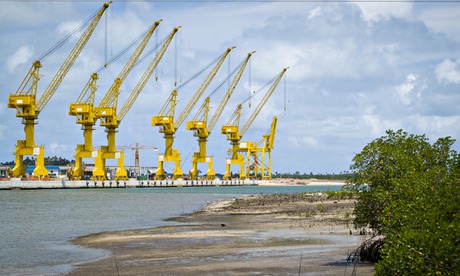
Cranes at Suape port in Brazil’s Pernambuco state tower over an adjacent mangrove swamp. Photograph: Felipe Ferreira/Getty Images
Edinilda de Ponto dos Carvalhos, who is in her early fifties, has been a marisqueira, or shellfish fisherwoman, in Suape since she was young. Recently, she says, her work has become much harder.
“There’s this chemical product in the water. It has no smell, but it kills everything,” she says. She believes the pollution comes from the nearby port complex in the Pernambuco state of Brazil, touted as one of the region’s main economic engines.
Another marisqueira, Valeria Maria de Alcántara, says: “The mud makes you itch, because of the oil and because of the debris that they throw in the sea. It burns the skin.”
According to the state’s rural worker training programme, women comprise 5,200 of the 8,700-strong local fishing community. They harvest shellfish standing in the water or meandering through mangrove forests on the shore.
On this bright morning, Dos Carvalhos and more than 20 other fisherwomen have come to talk about the collapse of their livelihoods as a result of pollution and the decimation of the mangroves. “Fisherwomen, who before in a week would get 20 to 30 kilos of shellfish, now take a whole week to get 2 or 3 kilos,” says De Alcántara, sitting on a folding metal chair in a dusty meeting hall.
Hundreds if not thousands of other women along the Pernambuco coast share her experience. Traditionally, marisqueiras‘ catches sustained their families and any surplus was sold on local beaches and in markets, supplementing the family’s main income. De Alcántara says she now works weekends cooking at a beachside bar to make up the financial shortfall caused by the drop in her catch.
“Throughout the history of fishing in Brazil, women’s activity has been rendered invisible,” says Laurinede Maria Santana. “What these women produce doesn’t enter into official fishing statistics.”
She says government policy marginalises the women’s work, and that it was only in the 1980s, when Brazil adopted its new constitution, that rural women workers won recognition and the right to a minimum pension.
Santana, who was born into a fishing family, supports fishing communities across the north-east through her work with the Pastoral Council of Fisherfolk (PCF), a Catholic group that helps organise artisan fishing communities across the country. In particular, she works with women to raise the visibility of their labour and the fruits of it, along with their self-esteem.
Between 2007 and 2010 the former president Luiz Inácio Lula da Silva poured about 1.4bn reals (£355m) into the Suape port complex to spur economic growth in his home state of Pernambuco, and private investment has followed.
The complex, just south of Recife, the state capital, is home to more than 100 businesses including an oil refinery, a petrochemical plant and two shipbuilding yards. The expansion has created thousands of jobs, but many are temporary and it has also come at a cost to the environment and communities practising traditional, sustainable livelihoods.
In September 2013, the state government’s environmental agency fined the port and industrial complex 2.5m reals for causing environmental damage, exemplified by the dynamiting of a section of coral reef near the port.
A spokeswoman for the port estimates that Suape contributes roughly 10% of the state’s annual income. The municipalities closest to the port can levy special industrial taxes on it too, but officials failed to respond to repeated requests for information on how much money this contributes to local coffers and how it is used.
“Suape is one of the current examples of the model of development the Brazilian government is adopting,” says the PCF’s vice-president, Maria José Pacheco. “It’s a model of development based on consumption, exploitation and the concentration of resources.”
The PCF has been working with other grassroots organisations to collect enough signatures to present congress with a bill that would establish protective areas around traditional fishing communities.
“These populations have a quality of life much higher, regardless of poverty, than the model that Brazil is offering with the industrialisation model,” Pacheco says.